Dr. Benjamin Macuil-Rojas
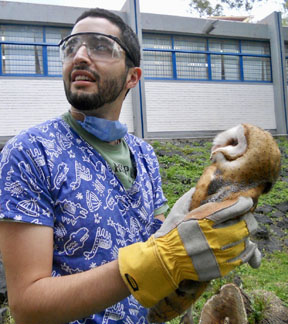
Photo courtesy of Dr. Benjamin Macuil-Rojas
Shown during his undergraduate days at the Universidad Nacional Autónoma de México, Dr. Benjamin Macuil-Rojas gently holds a barn owl that he tended at the avian hospital, one of multiple veterinary hospitals on the Mexico City campus.
Second of three parts
Lee este artículo en español
Lounging on his bed, bored, one afternoon in 2017, Dr. Benjamin Macuil-Rojas idly looked at his phone. The veterinary school graduate had recently finished a master's degree in regenerative medicine and cell therapy at the Universidad Nacional Autónoma de México in Mexico City. Between jobs and having nothing else to do, he scrolled listings on LinkedIn.
He paused at an ad for a position in New Mexico at Banfield Pet Hospital, a large veterinary practice chain based in the United States. Eh, he thought, why not apply? What do I have to lose?
Although stem cells fascinated him, research life did not. The son of a pediatric cardiologist, Macuil-Rojas wanted to return to clinical practice. As a student, he'd spent four months in the U.S. at two externships. Moving for a full-time post could be interesting.
Three days after he applied, Banfield called. Interviews followed. Then came an offer of a job in Phoenix, Arizona.
Distinct from every other veterinary school in Latin America, the program at UNAM, the nation's flagship public university, is accredited by the American Veterinary Medical Association Council on Education. UNAM gained the status in 2011, the same year Macuil-Rojas graduated. Macuil-Rojas knew that attending an AVMA-accredited program unlocked the door to working in the U.S., but pushing the door open and walking through was another matter.
There was first the issue of passing the North American Veterinary Licensing Exam, which is required of anyone who wishes to practice in the U.S. or Canada. The test is administered at locations around the world twice yearly. Because it had been six years since he finished the undergraduate veterinary program, Macuil-Rojas needed to review. He also needed to save money to pay the test fee of US$1,000-plus, equivalent to 2½ months' income he made when he worked as a practitioner in Mexico.
He thought, "If I pass it, perfect. If I don't pass, I'm not going to do it again. I don't want to waste money."
Macuil-Rojas studied for six months. (The company was willing to wait, a sign of its ongoing need for doctors.) When he finished the 6½-hour test, he had no idea how he'd done. After what felt like an interminable wait, he received an email with the happy news that he passed.
A paperwork slog soon eclipsed relief. He needed documents, including his birth certificate, to be translated and notarized. Few English-fluent notaries being available, he drove five hours from his home in León to the U.S. Embassy in Mexico City to take care of it.
Eleven months after being offered the job, in July 2018, Macuil-Rojas headed to the U.S. with a TN visa in hand. With him were his partner, four dogs and five cats. His mom, sister and brother-in-law drove the group north to Chihuahua, where the emigrants transferred to a van service that carried them 230 miles and across the border to El Paso, Texas. There, they rented another van to finish the journey to Arizona.
His stress amplified by worry about the pets (which were fine), Macuil-Rojas said of the arduous trip, "I never want to repeat that!"
And their ordeal wasn't over.
The newcomers arrived in Phoenix with no place to live. Moreover, "Nobody would rent to me because I didn't have a credit history [in the U.S.]," Macuil-Rojas discovered. After he found a trusting landlord, the same problem arose in setting up electricity, internet and telephone service.
"The first two months I was here, I was freaking out every day," he said in a video interview, eyes wide and hands waving at the memory. "I move to Arizona, it's the middle of July, and the AC breaks down. I was like, 'Is this a sign? Should I just go back home?' "
He also realized he needed a car "because public transportation in Arizona sucks!" His first trips to the supermarket were on foot in 110-degree heat.
Macuil-Rojas couldn't begin work right away because he didn't have a Social Security number. Upon applying, he was told that he needed an original copy of his birth certificate rather than the document he'd downloaded in Mexico. His mom and FedEx came to the rescue. Fortunately, his resubmitted application was processed in three days rather than the two weeks he'd been told to expect.
At last, he could work. The clinic where he was sent for training was too far to walk, so he called an Uber, which cost $30. The prospect of a $60 daily commute expense raised more anxiety, but in another bit of good fortune, it turned out that his new mentor lived near him. Macuil-Rojas was able to catch a ride for the rest of his monthlong training. At that point, he received a $25,000 sign-on bonus ($16,000 after taxes), providing the needed cash to buy a car.
UNAM Statue
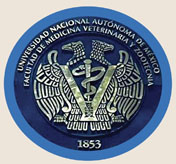
From there, life improved. About a year later, Macuil-Rojas was promoted to chief of staff of the hospital. "It was good feeling recognized," he said.
He found that his presence as a Spanish-speaker who understood Latin American culture drew new clients from a similar background. "One thing I noticed ... is how many people don't go to the vet because there's no one to speak Spanish to them," he said. "So when they knew I was there, I had a lot of people who [came] ... just because I speak Spanish. And it's not just the language. It's understanding where they come from culturally."
For example, neutering male dogs is not a given in Latin America. "It's probably, like, a macho thing," Macuil-Rojas explained. A doctor who understands that is less apt to judge the attitude and more willing to explain the medical rationales for desexing, he believes.
One of his first responsibilities as chief of staff was to train a new employee freshly graduated from Midwestern University in Glendale, a Phoenix suburb. Despite all he had accomplished, Macuil-Rojas felt intimidated, wondering what he could teach a U.S.-educated doctor.
"I felt that my education was not up to par of people who started here in the U.S.," he said. Although nothing has happened in his career to leave that impression, he'd internalized a sense of inferiority.
"And then I got this new grad and, of course, she's extremely smart and she's a very good doctor, but she didn't have the confidence that you get with years," he said. " ... It was at that moment that I realized, I am fully prepared to do this. It's just me holding myself back."
He added thoughtfully, "That was a big realization for me. … It made me feel good about my school and everything else."
Newcomer-turned-recruiter
More than a decade earlier, Banfield advocated for UNAM during the school's AVMA-accreditation effort. Its executives said at the time they hoped to hire graduates for jobs in the U.S. to increase the number of Spanish-speakers in their workforce. Nevertheless, Macuil-Rojas knows very few alumni working for the 3,600-veterinarian company — he can count the number on one hand. He'd like to change that.
Today, as area chief of staff for five practices in Arizona and a rising leader in the company on diversity issues, he is reaching out to students at his alma mater and elsewhere in Latin America to make them aware of employment opportunities in the U.S. and, if they wish to emigrate, to support their transition. His goal is to spare colleagues his grueling experience.
Macuil-Rojas said he gave a remote presentation in early June in a UNAM auditorium attended by about 40 students. A similar number listened online. The talk was recorded, posted on the school website and promoted on Facebook. Macuil-Rojas has since received emails from about a dozen students and veterinarians wanting to know more.
He also is trying to raise the profile of Banfield's presence in Mexico. He estimates that 90% of his colleagues in the company are unaware that their employer has a companion animal clinic in Mexico City, on the UNAM campus. (It's not mentioned on the company website about us page.) During the past six months, he and others at the company have been working on strengthening ties in Mexico, asking, "How can we have more communications? How can we bring your doctors here who want to work here?"
Why those lines of communication weren't established years ago is unclear. Dr. Scott Campbell, the Banfield president under whose leadership the Mexico City clinic was opened, stepped down in 2007, four years before UNAM became accredited. Macuil-Rosas said he believes that although some executives remained interested in cultivating the relationship, the nitty-gritty work of building a support network wasn't accomplished.
In response to an inquiry from the VIN News Service, a Banfield spokesperson provided a brief statement:
"Banfield Pet Hospital offers visa sponsorship and robust relocation resources to UNAM graduates who obtain a U.S. state veterinary license and want to start their career in companion animal medicine at one of our 1,000 hospital locations nationwide. Banfield continues to look at new ways the practice can provide additional support to UNAM students and graduates who are preparing for U.S. state licensure.
"Since [its] opening in 2005, we are proud of the impact Banfield's Mexico City hospital continues to have in helping UNAM students receive hands-on clinical training while providing local animals with the medical care they need."
Feeling welcome
Andrea Murrieta
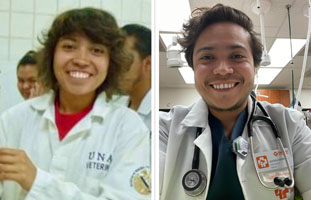
Photos courtesy of Dr. Andrea Murrieta
A transgender man, Dr. Andrea Murrieta attended school before his transition (left). After moving to the United States, he felt safe and accepted enough to come out (right).
Even before Macuil-Rojas formally began recruiting veterinarians from Latin America, he served as a conduit for Banfield to talent. Shortly after settling in Arizona, he learned that a friend and member of the UNAM class of 2013, Dr. Andrea Murrieta, was doing a small animal internship at Midwestern University in nearby Glendale. The two reconnected.
Now Murrieta works for Banfield, too.
Practicing internationally was something that interested Murrieta ever since he was a kid watching programs on the Discovery Channel and Animal Planet. "There were a few vet shows in there," he remembered, "and I was like, oh my God, I want to do that!"
Some of the veterinarians he admired on television were British, leading him to consider applying to veterinary school in the United Kingdom. But the near-zero tuition for Mexican citizens attending UNAM was too good to pass up. "I felt like I can always, after graduation, figure out how I can go and practice somewhere else," he said.
During a two-week rotation at the Banfield on-campus clinic while a student, Murrieta learned that the company has locations across the U.S. Interest piqued, he asked about the prospect for employment. The response was noncommittal. "They didn't give me an answer," he recalled.
In his experience since, Banfield is supportive of job candidates from UNAM once they've passed the NAVLE. That makes sense to him. "I understand that is a risk for them because what if you don't pass? Once you pass, they offer a relocation bonus and a hiring bonus, which is pretty good, especially coming from a school that was free and you don't have any [educational] debt," Murrieta said.
While interning in Arizona, he interviewed at a variety of hospitals. He chose Banfield in part because it was familiar. Also, he said, "I felt like the benefits were better. Even the pay was a little better. And the fact that they help you with the work visa, as well." Its status as a big corporation gives him a sense of economic security.
He also has gained a more personal sense of security — to be himself. Murrieta is a transgender man. He did not express his identity in Mexico, a deeply Catholic country with a generally conservative bent. "It was only when I started working at Banfield that I felt safe and comfortable to start my transition," he said. "Banfield has provided me with all the support, and they are very good with diversity."
Sensing more respect for the profession
Dr. Mayra Fortozo
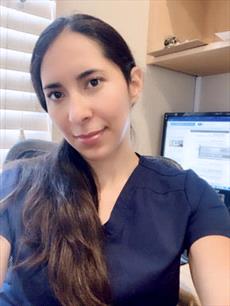
Photo courtesy of Dr. Mayra Fortozo
Before moving to Canada last year, Dr. Mayra Fortoso considered relocating to Texas because it has a sizable Spanish-speaking population, and she would be closer to family in Mexico. But trying to grasp U.S. immigration requirements was daunting. "You have to hire a lawyer," she said. "It's not tailored for a normal person to read and to understand."
Dr. Mayra Fortozo is a UNAM alum who traded practice ownership in Mexico City for a job as an associate in Toronto last fall. She senses greater respect for her profession in her new home. Certainly, veterinarians are paid substantially better.
Dr. Rodrigo Cedillo Flores, a 2018 UNAM graduate practicing in Halifax, Nova Scotia, called working conditions in Mexico "abysmal" compared with Canada's. General practitioners in Mexico work an average of 50 hours per week, he said, for an income of US$300 to $500 per month in big cities. "Old practices won't give health coverage or even a work contract, and the competition is brutal," he added. In his experience, new veterinarians in Canada are paid around CA$80,000 (US$62,000) a year and work 40 hours a week. "I've noticed that veteran doctors work part-time," he added.
At the same time, the cost of living in Canada is much higher than in Mexico, Fortozo noted, as is the cost of veterinary care. "It's difficult to really make an accurate comparison because the economies are very different ..." she said. "Nevertheless, I think that in Mexico, unfortunately, veterinarians are underpaid."
One of Fortozo's frustrations with practicing in Mexico was that, although she'd studied an extra two years to specialize in dog and cat medicine and surgery, her expertise wasn't valued by pet owners. "I was not able to charge more for my knowledge compared with those who had never gotten into a specialty," she said.
Further, she said, Mexico does not have a licensing authority that continuously evaluates practitioner quality. "As soon as you finish college and get your degree, you obtain your license, expedited by the government, and you can start practicing without restrictions. It is never renewed or monitored," Fortozo said. "Here [in Canada], the licensing process is hard. So if you get to the point of getting a license and calling yourself a veterinarian, it means you have passed many tests after graduating."
Learning the lingo, supporting peers
Dr. Patricia Rosas
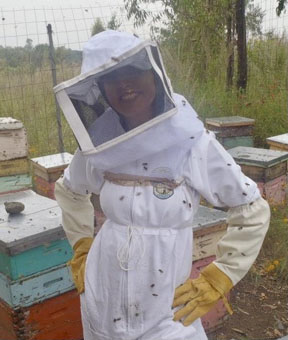
Photo courtesy of Dr. Patricia Rosas
Passionate about insects, Dr. Patricia Rosas worked in bee medicine in Mexico before moving to Canada in search of greater opportunities.
Dr. Patricia Rosas, a 2016 UNAM graduate working in Alberta, Canada, similarly felt constrained by the professional opportunities in Mexico. As a student, she'd fallen in love with bee medicine, an important and potentially lucrative sector in a country that ranks among the world's top honey producers.
Rosas enrolled at UNAM shortly before the program gained U.S.-accreditation. She was indifferent to news of the achievement. "I thought, 'What does it matter? I'm going to work here with bees in Mexico.' "
After graduating, though, Rosas found it hard to break into the sector, she said: "It's really male-dominated."
General practice held less appeal, owing to its lower income potential. "People are used to not having to pay a lot for medical services for themselves, so they don't do it for their pets," Rosas said, explaining, "Medical services in Mexico are free."
Still, Rosas didn't think about practicing internationally until her brother, an oil industry geological engineer in Alberta, suggested, "Why don't you come to Canada? You have English [skills]. You have the accreditation."
"Oh yeah!" Rosas replied. "I have that."
So in the summer of 2019, she began sending her resume to veterinary employers in Alberta. Job offers followed within a week. By September, she had moved to Canada.
Because she hadn't yet taken the NAVLE, Rosas initially worked as a clinic receptionist, then a veterinary assistant with increasing responsibilities.
Although Rosas speaks English fluently, she had lingo to learn. "I didn't know all the words for, like, Q-tip or Band-Aid," she recounted. "Drugs are different; brands are different. Some drugs that I used to use in Mexico are not approved in Canada. The diseases are different. What they get [sick from] in Mexico they don't get here because the weather is different."
Once she passed the NAVLE, in summer 2020, and obtained her veterinary license, Rosas moved to a different practice for a fresh start. Where she worked before, "everyone knew me as a vet tech or whatever else, but not the vet," she said. "So I said, 'Thank you so much, I learned a lot ... but I need [to be] somewhere that sees me as a vet.' "
Dr. Rodrigo Cedillo Flores
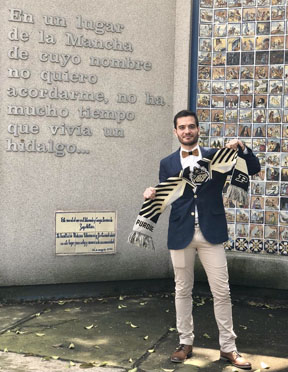
Photo courtesy of Dr. Rodrigo Cedillo Flores
Standing by a tile wall depicting scenes from the story of Don Quixote, Dr. Rodrigo Cedillo Flores celebrates his graduation in 2018 from veterinary school at UNAM. He holds a scarf given to him by friends at Purdue University, where he had an externship the previous year. Many UNAM graduates who work abroad first experienced working outside Mexico through training stints in other countries.
When she planned to take the NAVLE, Rosas joined a chat group of other Mexico natives studying for the test. Of seven in the group, four have passed so far. They remain in the group to support and encourage the rest.
Flores, the UNAM graduate in Halifax, having arrived there in October, similarly serves as a resource to others considering international practice. "I haven't been in Canada for an extended period. Still, from day one, students are in contact to get some directions on preparing for the NAVLE, and I'm down for it," he said. "Any helpful advice I can give them, I will do it."
He landed his job through informal networking. A classmate had shared a "working in Canada" webinar on Facebook. That was in April 2021. He took the NAVLE in May, and signed a job contract a month later.
Flores said he knows at least five classmates who moved to Canada in 2021. He also knows peers practicing in the U.S., Ecuador and France.
'She's going to be a rock star'
Back when UNAM was pursuing U.S. accreditation, Dr. Brian Speer, owner of an avian specialty practice in California, was skeptical. In a recent interview, he recalled thinking, "Oh my God, is this going to be a fast-tracking thing, with faulty science and erosion of some of the key components of good medical care?"
Speer had gone to UNAM as a visiting lecturer before its veterinary school was accredited. He told VIN News in 2010 that the program left a positive impression; that faculty and students were "passionate to raise care standards."
Dr. Vanessa Hernandez
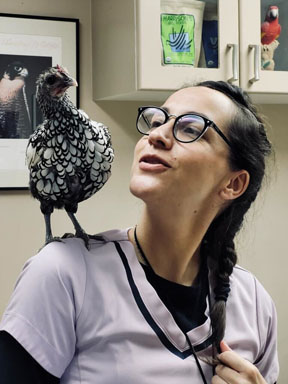
Photo courtesy of Dr. Vanessa Hernández
Dr. Vanessa Hernández, a Sebright hen on her shoulder, is an intern at The Medical Center for Birds in Northern California. The 2011 UNAM graduate says U.S. accreditation of her school brought about curriculum changes that enabled her to focus on her favorite animal rather than requiring learning on a breadth of species. "I was sure I was never going to study sheep," she said.
Still, he said at the time, "There's work to be done there. The thing that caught my eye was the humongous Banfield sign and the corporate over- and undertones. Of course," he added, "that also is occurring at U.S. schools."
Speer's knowledge of UNAM was limited to that single visit until fall 2020, when he hired an intern from the class of 2011, Dr. Vanessa Hernández. Pursuing a master's in avian science at UNAM following her undergraduate studies, Hernández previously had spent a few weeks as an extern at Speer's practice.
The practice frequently hosts visiting colleagues from other countries, Speer said, but Hernández is the first foreign national on staff. "It's challenging getting them through — passing the national boards and then getting licensed in the state," he discovered. "It's a lot more hurdles than I was used to."
The other thing Speer learned is that, at least in his experience with Hernández, the education provided by UNAM is robust.
For her part, Hernández credits accreditation with opening new worlds of study. Instead of being required to learn about an array of species, from sheep to horses to cats and dogs, Hernández said she could quickly home in on the animal she loved most.
"Fanatically bird-oriented" is how Speer describes Hernández, with "the right personality and drive. She's going to be a rock star," he raved.
In selecting candidates for internships, Speer said that as long as their core understanding of medical science is strong, what he cares most about are their intrinsic qualities: "self-leadership and passion and drive."
"Those things," he said, "are not trained by any university."
Next: Leaving Mexico to practice via a harder route